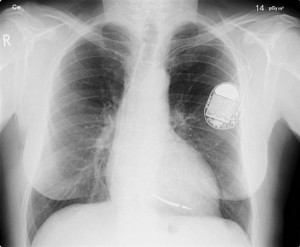Scientists are developing next-generation battery-free implantable pacemakers that may be powered by an unlikely source, the heart itself. The advancement is based upon a piezoelectric system that converts vibrational energy, created inside the chest by each heartbeat, into electricity to power the pacemaker. “Essentially, we’re creating technology that will allow pacemakers to be powered by the very heart that they are regulating,” said M Amin Karami, assistant professor of mechanical engineering at the University at Buffalo School of Engineering and Applied Sciences, who is leading the research.
The technology may eliminate the medical risks, costs and inconvenience of having a battery replacement every five to 12 years for millions of people worldwide, researchers said. About the size of a pocket watch, pacemakers are implanted under the skin through an incision in the chest. Wires, also called leads, connect the device to the heart and deliver electrical signals that regulate the heart’s activity. The new wireless option does not require leads because it rests inside the heart. This removes a potential point of failure, but the device still relies on a battery that must be replaced as often as the batteries that conventional pacemakers use.
The idea of heart-powered pacemakers came to Karami after doing PhD work on piezoelectric applications for unmanned aerial vehicles and bridges. He wanted to apply that knowledge to the human body. The heart was an obvious choice because of its relative strength and constant motion. “To see the heart in motion even an animation is to be awestruck. It moves significantly. In turn, that movement creates energy that we’re just now figuring out how to harvest,” said Karami.
Karami initially designed a flat piezoelectric structure for a conventional pacemaker. A prototype generated enough power to keep the pacemaker running at a range of 7 to 700 beats per minute. With the development of wireless pacemakers, however, he has revamped the design to accommodate the smaller, tube-shaped device. Currently, Karami is in talks with device-makers, besides building the new prototypes of the battery-free pacemakers and expects tests on animals to be performed within the next two years. Once finished, it would be up for human clinical trials and finally await approval from the U.S. Food and Drug Administration. If it receives approval, the technology is expected to curb the medical costs, inconvenience and even risks of having battery replacement every 5 to 12 years for millions of pacemaker dependent people. Wireless pacemakers that have been successfully developed are in the first stages of clinical trials in Australia, Canada and the United States. A battery-free pacemaker is also in the making in Switzerland at the University of Berne.
For more information please visit: www.buffalo.edu

